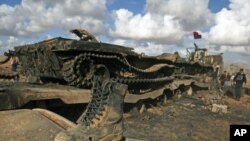Western military officials say the no-fly zone over Libya is successfully established. Now people are interested in what it takes to sustain a no-fly zone and are asking what comes next?
The international coalition is acting under a United Nations resolution that set up a no-fly zone to prevent Libyan leader Colonel Moammar Gadhafi from using air power against the Libyans who have risen up against him. The resolution also authorizes member states to "take all necessary measures" to protect civilians and civilian-populated areas under threat of attack.
Experts say the coalition-imposed no-fly zone has pinned Gadhafi’s air force to the ground and his air defense system is largely destroyed.
But Ward Carroll, a former Navy radar specialist who flew in aircraft patrolling earlier no-fly zones over Iraq and Bosnia, said it is far easier to establish a no-fly zone than to maintain it.
"Let’s imagine we are doing this 24 hours a day, seven days a week and I would submit that’s the amount of level that is going to take to do this right," said Carroll. "Traditionally, the Libyans don’t fly at night so you could probably reduce your level of effort after dark. But you still need early-warning aircraft, you still need other support aircraft, and you need airplanes that are ready to react in the event that pro-Gadhafi forces do fly and continue to attack rebel forces after dark."
Carroll said the military hardware needed to successfully patrol the no-fly zone goes beyond jet fighters. "It’s the assets that support those airplanes - so that takes Harrier jets and Cobra helicopters and then the tanker assets that keep those airplanes airborne. So there is a lot, not to mention the entire command and control structure."
Carroll notes the operation also is expensive. "The cost estimates around the initial wave of strikes is $1 billion. And then it takes something between $100 million and $300 million per week to maintain a no-fly zone."
Despite the effort and costs, however, analysts say there is little evidence that coalition air strikes on Gadhafi’s forces have prevented them from attacking civilians.
Retired Air Force General Mike Dunn commanded airmen who patrolled no-fly zones. "If the mission is what it seems to be, which is protecting Libyan civilians, then protecting them from aircraft is only part of the mission. The other part of the mission is to protect them from Libyan ground forces - and that’s a completely different mission that we haven’t seen much action on thus far. And it is much more difficult."
Marc Ginsberg, former U.S. ambassador to Morocco, agrees with those who say air power has its limits. "The real dilemma is that we’ve already succeeded in imposing a no-fly zone. But the battle is really taking place on the ground, in urban areas where a no-fly zone is not going to stop mortars and tank shells from flying into opposition strongholds. And so the no-fly zone was a great idea three weeks ago, but it’s no longer an applicable aspect of trying to prevent a humanitarian challenge no matter where you are in Libya."
So the question now is, according to experts, would ground forces be necessary to stop civilian casualties?
Not U.S. forces, said Ambassador Ginsberg. "I think it would be an unmitigated disaster for the United States to put ground troops on the ground. Let the French do it - the French were the ones most interested in starting this conflict with Gadhafi - the French foreign legion on the shores of Tripoli."
Many analysts, such as Carroll, say there is little political appetite in the United States to send ground troops to Libya after Iraq and Afghanistan.
"And this also has a fiscal component - we don’t have the money in the face of these deficits and this job unemployment situation to be involved in this for too very long. But we’ll see," said Carroll.
Despite the difficulties, though, Carroll said that when innocent people are being killed, the American people do not want to stand idly by.













